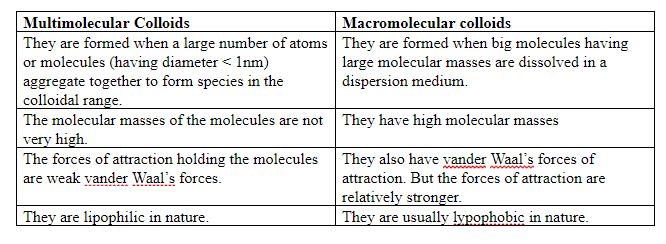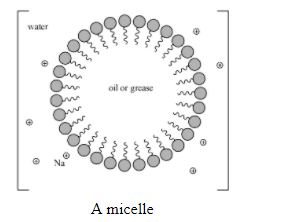
Answer
407k+ views
Hint: In colloidal state, the size of the particles varies from 1 nm to 100 nm (or\[{{10}^{-9\text{ }}}\text{to 1}{{\text{0}}^{-7}}\text{ m}\]). If some insoluble solid particles are dispersed in a medium such that after dispersion their particle size lies in the colloidal range then depending upon the way of forming colloidal size particles, these dispersion mediums are called as multimolecular, macromolecular and associated colloids.
Complete step by step solution:
Differences between multimolecular and macromolecular colloids:

Examples of multimolecular colloid:
-Gold sol and sulphur sol consist of thousands of particles held together by vander Waal’s forces.
Examples of macromolecular colloids:
-Macromolecules like starch, cellulose, proteins, polymer like rubber, and gelatin. These molecules have sizes in the colloidal range and their dispersion forms macromolecular colloids.
-Associated colloids are different from multimolecular and macromolecular colloids in the way as follows:
Substances when dissolved in a medium at low concentrations behave as normal electrolytes but at higher concentration aggregate to form a micelle are associated colloids. The narrow concentration range over which the physicochemical properties of particles change due to the formation of oriented colloidal aggregates is called critical micelle concentration (CMC) and the aggregates formed are called micelles. For example: surface active agents like soaps and detergents.
No micelle formation takes place in either of the two colloids i.e. multimolecular and macromolecular colloids.

Additional Information: The formation of micelle takes place at a particular temperature called Kraft temperature (\[{{T}_{k}}\]).
Note: Carefully note the characteristics and conditions for all the three types of colloids. Students are more likely to get confused between multimolecular and macromolecular colloids. Multi means many so, in multimolecular many different particles combine to give a colloidal size particle whereas in macromolecular colloids, individual particles have colloidal size.
Complete step by step solution:
Differences between multimolecular and macromolecular colloids:

Examples of multimolecular colloid:
-Gold sol and sulphur sol consist of thousands of particles held together by vander Waal’s forces.
Examples of macromolecular colloids:
-Macromolecules like starch, cellulose, proteins, polymer like rubber, and gelatin. These molecules have sizes in the colloidal range and their dispersion forms macromolecular colloids.
-Associated colloids are different from multimolecular and macromolecular colloids in the way as follows:
Substances when dissolved in a medium at low concentrations behave as normal electrolytes but at higher concentration aggregate to form a micelle are associated colloids. The narrow concentration range over which the physicochemical properties of particles change due to the formation of oriented colloidal aggregates is called critical micelle concentration (CMC) and the aggregates formed are called micelles. For example: surface active agents like soaps and detergents.
No micelle formation takes place in either of the two colloids i.e. multimolecular and macromolecular colloids.

Additional Information: The formation of micelle takes place at a particular temperature called Kraft temperature (\[{{T}_{k}}\]).
Note: Carefully note the characteristics and conditions for all the three types of colloids. Students are more likely to get confused between multimolecular and macromolecular colloids. Multi means many so, in multimolecular many different particles combine to give a colloidal size particle whereas in macromolecular colloids, individual particles have colloidal size.
Recently Updated Pages
Write the IUPAC name of the given compound class 11 chemistry CBSE

Write the IUPAC name of the given compound class 11 chemistry CBSE

Write the IUPAC name of the given compound class 11 chemistry CBSE

Write the IUPAC name of the given compound class 11 chemistry CBSE

Write the IUPAC name of the given compound class 11 chemistry CBSE

Write the IUPAC name of the given compound class 11 chemistry CBSE

Trending doubts
Fill the blanks with the suitable prepositions 1 The class 9 english CBSE

How do you graph the function fx 4x class 9 maths CBSE

Which are the Top 10 Largest Countries of the World?

Which is the longest day and shortest night in the class 11 sst CBSE

What is the definite integral of zero a constant b class 12 maths CBSE

Name five important trees found in the tropical evergreen class 10 social studies CBSE

The Equation xxx + 2 is Satisfied when x is Equal to Class 10 Maths

Differentiate between homogeneous and heterogeneous class 12 chemistry CBSE

Difference between Prokaryotic cell and Eukaryotic class 11 biology CBSE




